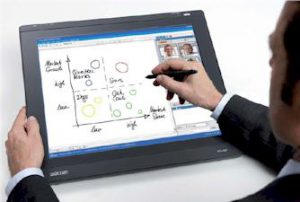
Last week at Online Educa 2009 I stopped by at the Wacom booth to take a look at their latest range of graphics tablets. I was interested because they’ve started to promote their hardware as a useful aid for anyone running live web conferencing sessions. A graphics tablet is a far superior drawing device to a mouse and much better suited to sketching on an electronic whiteboard. If a facilitator adds a tablet to their kit, they’ll be able to work on-screen much as they do on a conventional whiteboard or flip chart. I reckon that could make a very significant difference in terms of engaging learners and break the reduce our dependence on PowerPoint slides. I’ve got a small Wacom tablet tucked in a drawer, so I’ll be dusting that down before my next live session.
Wacom have prepared a free white paper on the use of graphics tablets in web conferencing, which can be downloaded here.
Graphics tablets bring whiteboards to life
Reviews the potential of graphics tablets as input devices for web conferencing whiteboards.
